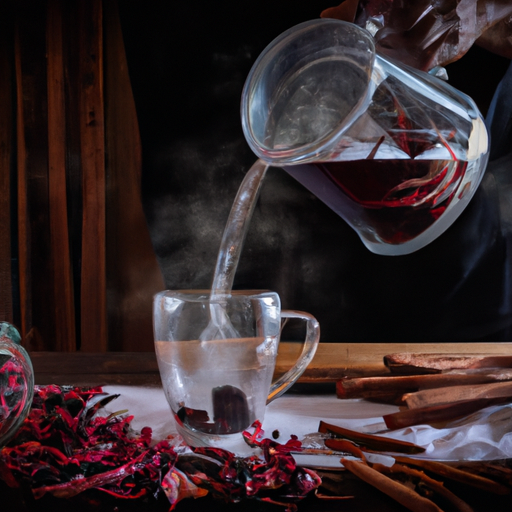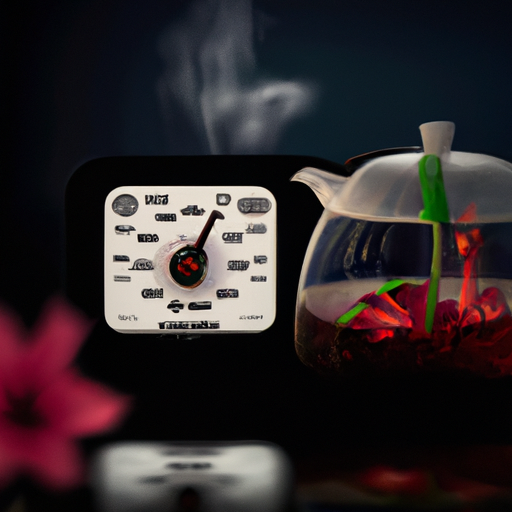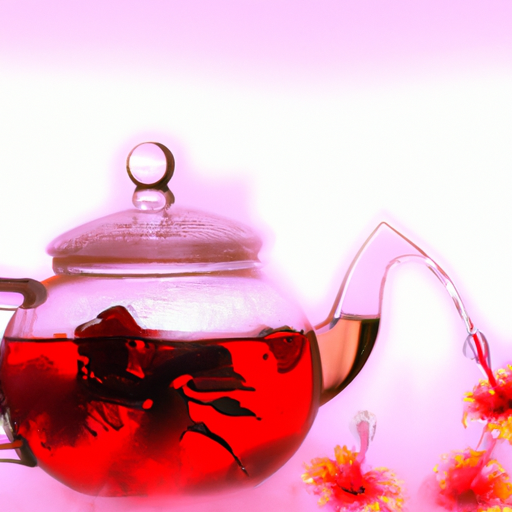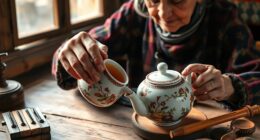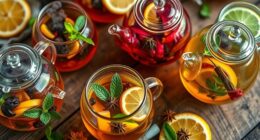Having battled high blood pressure for many years, I’ve come to recognize the significance of identifying natural solutions for controlling this issue. A natural remedy that has emerged as a popular choice recently is hibiscus tea.
Not only is it a delicious and refreshing beverage, but studies have shown that it can also lower blood pressure and improve overall cardiovascular health.
In this article, I will guide you through the process of making hibiscus tea for high blood pressure. From choosing the right flowers to understanding how the tea works to lower blood pressure, you’ll learn everything you need to know about incorporating this powerful drink into your daily routine.
So grab your teapot and let’s get started!
Key Takeaways
- Hibiscus tea is a natural remedy for managing high blood pressure and can improve cardiovascular health.
- Choosing the right flowers, measuring accuracy, and boiling water properly are important for maximum effectiveness when preparing hibiscus tea.
- Safe consumption practices, including following safe brewing and storage practices, using filtered/bottled water, and limiting intake to 3 cups per day, are essential for optimal health outcomes.
- Consulting with a doctor before making drastic diet changes is recommended. Enjoying hibiscus tea can be a delicious way to improve health outcomes.
Understanding High Blood Pressure
Don’t ignore high blood pressure – it can lead to serious health problems like heart disease and stroke.
High blood pressure, or hypertension, occurs when the force of blood against artery walls is consistently too high. This condition can be caused by a variety of factors such as family history, age, obesity, smoking, lack of physical activity, and stress.
Fortunately, there are lifestyle modifications that can help manage hypertension. These include maintaining a healthy weight through regular exercise and a balanced diet low in sodium and saturated fats. Reducing alcohol intake and quitting smoking can also have a positive impact on blood pressure levels.
In addition to these changes, incorporating hibiscus tea into your routine may offer additional benefits for those with high blood pressure. Choosing the right hibiscus flowers is important in ensuring maximum effectiveness in managing this condition.
Choosing the Right Hibiscus Flowers
When it comes to selecting the perfect hibiscus blooms, it’s all about finding the ones that remind you of a warm summer day in the tropics. To make hibiscus tea for high blood pressure, it’s essential to choose fresh flowers. The fresher the flower, the more potent its medicinal properties will be.
Fresh hibiscus flowers are often found at local farmers’ markets or specialty stores. Look for flowers that haven’t yet fully opened, and avoid those with brown spots or wilted petals. If you can’t find fresh flowers, opt for dried ones instead. Just make sure they’re organic and haven’t been exposed to any harmful chemicals.
When choosing between natural and dried options, keep in mind that natural hibiscus flowers will yield a stronger flavor and more significant health benefits than their dried counterparts. However, if you do decide to use dried flowers, soak them in hot water for several minutes before brewing your tea to rehydrate them.
Now that we’ve selected our perfect blooms, let’s move on to preparing the tea leaves!
Preparing the Tea Leaves
Before we can steep our hibiscus tea, it’s important to prepare the tea leaves correctly. Firstly, I always measure out the right amount of dried flowers for my desired strength and flavor.
Secondly, boiling water is essential for extracting all the beneficial compounds from the leaves.
Lastly, I let the tea steep for at least 5-10 minutes before straining and enjoying.
Taking these steps ensures a delicious and healthful cup of hibiscus tea every time!
Measuring the Right Amount
To get the perfect balance of flavor and health benefits, you’ll want to measure out one tablespoon of dried hibiscus flowers per cup of water. Measuring accuracy is key here, as too much or too little can affect the taste and potency of the tea. Once you’ve measured out the right amount, place it in a tea strainer or infuser and set it aside.
Next, boil your water and pour it over the hibiscus flowers in your teapot or mug. Steeping duration is also important for getting the most out of your tea. Let it steep for about 5 minutes before removing the strainer or infuser.
Now that we’ve measured out our ingredients correctly and allowed them to steep properly, let’s move on to boiling the water for our next step.
Boiling the Water
First, you’ll need to bring your water to a rolling boil. Boiling the water properly is an essential step in making hibiscus tea for high blood pressure. You can’t just heat up any old pot of water and expect it to produce a flavorful and healthy tea.
To achieve the perfect boiling temperature, use fresh cold water and place it in a pot over high heat until it reaches 212°F (100°C). Once the water starts boiling, reduce the heat to medium-low, so that it simmers gently. This will ensure that the water doesn’t evaporate too quickly or become too hot, which could ruin the flavor of your hibiscus tea.
With this technique, you’ll have perfectly boiled water for brewing your hibiscus tea.
Now that you’ve got your boiling technique down pat, let’s move on to brewing the tea!
Brewing the Tea
Now that we’ve got our hibiscus tea leaves ready, it’s time to brew the perfect cup. The steeping time and temperature are crucial factors in achieving the ideal flavor and health benefits of the tea.
I personally like to steep my hibiscus tea for 5-7 minutes at a temperature of 190°F to avoid over-extraction or bitterness. Additionally, you can add natural sweeteners like honey or citrus flavors like lemon for an extra burst of flavor without compromising its health benefits.
Steeping Time and Temperature
As the hibiscus tea leaves steep in hot water, their vibrant red color infuses into the liquid. It’s important to pay attention to the steeping time and temperature to ensure optimal brewing and health benefits.
The ideal temperature for steeping hibiscus tea is around 212°F (100°C), which is just below boiling point. Steeping for too long can result in a bitter taste, so it’s recommended to brew for no more than 5-7 minutes.
To further enhance the flavor of your hibiscus tea, you can add honey or lemon juice. These natural sweeteners not only add flavor but also provide additional health benefits such as immune system support and digestive aid.
Another option is to mix in herbs like mint or ginger for added complexity and depth of flavor. By experimenting with different additions, you can create a personalized blend that suits your taste preferences and offers unique health benefits.
Adding Flavorings
Enhance the flavor of your hibiscus infusion by adding natural sweeteners like honey or lemon juice. These options offer a delicious taste and an extra boost of health benefits to make you feel amazing.
Honey, in particular, has anti-inflammatory properties that may help reduce blood pressure and improve heart health. Lemon juice contains vitamin C, which is a powerful antioxidant known for reducing oxidative stress and inflammation.
When it comes to brewing variations, some people prefer to add spices such as cinnamon or ginger to their hibiscus tea for added flavor. Others enjoy mixing different types of teas together to create unique blends.
Whatever your preference may be, experimenting with different flavoring options can help keep your hibiscus tea experience exciting and enjoyable.
Now that we’ve covered how to enhance the flavor of your hibiscus tea, let’s move on to serving and drinking the tea itself.
Serving and Drinking the Tea
Pour the fragrant hibiscus tea into a tall glass filled with ice, and savor each refreshing sip while relaxing in the shade. To add an extra touch of elegance to your serving, consider using a clear glass teapot or infuser, allowing guests to see the vibrant red color of the brew. You can also experiment with different garnishes such as mint leaves, slices of lemon or orange, or even edible flowers like lavender.
When it comes to drinking hibiscus tea for high blood pressure, there are no strict rules on how much or how often you should consume it. Most studies have used between 2-3 cups per day, but it’s always best to consult with your doctor before making any drastic changes to your diet.
As a general guideline, aim for at least one cup in the morning and another in the afternoon or evening.
Now that you know how to serve and drink hibiscus tea, let’s dive into its potential benefits for managing high blood pressure. By reducing inflammation and acting as a natural diuretic, this herbal infusion may help lower blood pressure levels over time.
So sit back, relax, and enjoy all that hibiscus tea has to offer!
How Hibiscus Tea Lowers Blood Pressure
I find it fascinating to learn about the science behind how hibiscus tea can lower blood pressure.
Through clinical studies and research, we know that hibiscus contains compounds that act as natural ACE inhibitors. These help relax blood vessels and improve circulation.
Additionally, hibiscus has been shown to have antioxidant properties which may also contribute to its blood pressure-lowering effects.
Overall, it seems that hibiscus tea has multiple mechanisms for reducing blood pressure levels.
The Science behind the Effects
Understanding the way hibiscus tea influences blood pressure requires a closer look at the chemical interactions occurring in the body. Here are some key points to consider:
- Hibiscus tea is rich in antioxidants, which help to protect cells from damage caused by free radicals.
- The flavonoids found in hibiscus flowers have been shown to have vasodilatory effects, meaning they can widen blood vessels and improve blood flow.
- Hibiscus tea has diuretic properties, which means it can increase urine output and reduce fluid buildup in the body.
- Research suggests that regularly consuming hibiscus tea may also decrease levels of angiotensin-converting enzyme (ACE), an enzyme involved in regulating blood pressure.
While there are potential risks associated with consuming large amounts of hibiscus tea, most studies suggest that drinking 2-3 cups per day is safe for most people.
Overall, these findings point to the potential benefits of incorporating hibiscus tea into a high blood pressure management plan. However, it’s important to consult with a healthcare provider before making any significant changes to your diet or medication regimen.
Moving on to clinical studies and research…
Clinical Studies and Research
Now that we have a basic understanding of the science behind how hibiscus tea can help lower high blood pressure, let’s take a look at some clinical studies and research to support these claims.
One study published in The Journal of Nutrition found that consuming hibiscus tea daily for 6 weeks resulted in significant reductions in both systolic and diastolic blood pressure among adults with pre- to mild hypertension. Additionally, a meta-analysis of multiple studies found that hibiscus tea consumption was associated with an average reduction of 7.58 mmHg in systolic blood pressure and 3.53 mmHg in diastolic blood pressure.
While these findings are promising, it’s important to note that there may be potential risks associated with consuming large amounts of hibiscus tea, such as gastrointestinal discomfort or interactions with certain medications. As always, it’s recommended to consult with a healthcare professional before incorporating any new supplements or beverages into your routine.
In terms of dosage recommendations, most studies have used around 2-3 cups per day of brewed hibiscus tea or standardized extracts containing 250-1000 mg/day of anthocyanins (the active compounds believed to contribute to its blood pressure-lowering effects).
Moving on from the potential risks and dosage recommendations for drinking hibiscus tea for high blood pressure, let’s explore other health benefits this delicious beverage has to offer.
Other Health Benefits of Hibiscus Tea
I’m excited to explore the other health benefits of hibiscus tea.
One key benefit is its antioxidant properties, which means it can help protect our cells from damage caused by free radicals.
Additionally, hibiscus tea has anti-inflammatory effects that may contribute to reducing the risk of chronic diseases like heart disease and cancer.
Antioxidant Properties
You’ll love that hibiscus tea has antioxidant properties, which can help protect your cells from damage caused by free radicals. Antioxidants are compounds that prevent oxidative stress and reduce the risk of chronic diseases like cancer, diabetes, and heart disease. Hibiscus tea is rich in antioxidants called anthocyanins that give it its deep red color.
To put things into perspective, let’s take a look at a table comparing the antioxidant content of hibiscus tea with other popular beverages:
| Beverage | ORAC Value |
|---|---|
| Hibiscus Tea | 3,225 |
| Green Tea | 1,253 |
| Red Wine | 2,029 |
| Pomegranate Juice | 2,341 |
As you can see from the table above, hibiscus tea has a higher oxygen radical absorbance capacity (ORAC) value than green tea and red wine. This means that drinking hibiscus tea regularly may provide more antioxidant benefits than these other beverages. In the next section, we’ll explore how these antioxidants also contribute to the anti-inflammatory effects of hibiscus tea.
Anti-inflammatory Effects
With hibiscus tea, you can soothe inflammation in your body and potentially improve your overall health. This is because hibiscus tea contains anti-inflammatory properties that can help alleviate pain and discomfort caused by inflammation.
In a study published in the Journal of Ethnopharmacology, participants who drank hibiscus tea experienced reduced levels of inflammatory markers in their blood. Hibiscus tea may also have benefits for skin health.
A study published in the Journal of Traditional and Complementary Medicine found that applying a topical hibiscus extract to the skin reduced redness and swelling caused by UV radiation exposure. While more research is needed to fully understand the effects of hibiscus on skin health, these findings suggest that incorporating hibiscus tea into your routine could provide some benefits beyond just its potential to lower blood pressure.
Incorporating hibiscus tea into a healthy lifestyle can be as simple as swapping out sugary drinks for this flavorful and nutritious beverage.
Incorporating Hibiscus Tea into a Healthy Lifestyle
By including hibiscus tea into your daily routine, you can take control of your health and feel empowered to make positive choices for yourself. Here are five ways to incorporate this healthy beverage option into your lifestyle:
- Start your day with a cup of hibiscus tea instead of coffee or sugary drinks.
- Brew a large batch and keep it in the fridge for a refreshing and hydrating alternative to soda or juice.
- Replace alcoholic beverages with hibiscus tea during social occasions.
- Use hibiscus tea as a base for smoothies or iced teas by adding fresh fruit and herbs.
- Experiment with different flavors by mixing hibiscus tea with other herbal teas like mint, ginger, or chamomile.
Not only does incorporating hibiscus tea into your life provide numerous health benefits, but it also encourages making mindful choices about what we consume. As we become more aware of our habits, we can begin to cultivate positive changes that contribute to overall wellness.
In addition to these lifestyle changes, it’s important to note that there are precautions and possible side effects when consuming any new substance. Let’s explore these further in the next section.
Precautions and Possible Side Effects
Before incorporating hibiscus tea into your diet, it’s important to be aware of potential precautions and side effects. As someone who regularly drinks hibiscus tea for its health benefits, I’ve found that there are certain things to keep in mind.
These include drug interactions, allergic reactions, and safe consumption practices. It’s always best to consult with a healthcare provider before making any major changes to your diet or lifestyle.
Drug Interactions
Unfortunately, if you’re taking any medications, it’s important to check with your doctor before adding hibiscus tea to your routine as it can interact with certain drugs. Specifically, hibiscus tea may interact with blood pressure and diabetes medications. When taken together, the combination may cause a dangerous drop in blood pressure or blood sugar levels.
It’s important to note that the dosage of hibiscus tea should also be closely monitored when taken with medication. In general, it’s recommended to consume no more than 3 cups of hibiscus tea per day. However, this recommendation may vary depending on individual circumstances and health conditions. With proper guidance from a healthcare provider, incorporating hibiscus tea into your routine can be a safe and effective way to manage high blood pressure.
Moving onto the next section about allergic reactions, it’s important to keep in mind that while hibiscus tea is generally considered safe for most people when consumed in moderation, some individuals may experience allergic reactions.
Allergic Reactions
As we’ve discussed, hibiscus tea can interact with certain medications and cause adverse effects. However, another concern that needs to be addressed is the potential for allergic reactions.
Common allergens such as pollen, dust mites, and certain foods can trigger an allergic reaction in some individuals. In the case of hibiscus tea, it’s possible for someone to develop an allergy to the plant itself or any of its components.
If you experience symptoms such as itching, swelling, hives, difficulty breathing or swallowing after drinking hibiscus tea, stop consuming it immediately and seek medical attention. Managing allergic reactions involves avoiding exposure to the allergen and taking antihistamines or other medications as prescribed by a doctor.
It’s important to note that severe allergic reactions can lead to life-threatening conditions such as anaphylaxis.
Moving forward into safe consumption practices when making hibiscus tea for high blood pressure, there are several precautions that should be taken into consideration.
Safe Consumption Practices
To ensure your safety while enjoying the health benefits of hibiscus tea, it’s important to follow these recommended consumption practices. Firstly, make sure you are brewing the tea in a safe and hygienic manner. Use filtered or bottled water to avoid any impurities that may be present in tap water. Boil the water first before steeping the hibiscus flowers for 5-7 minutes, then strain and discard the flowers.
Secondly, proper storage practices are also crucial to maintaining the safety and quality of your hibiscus tea. Store it in an airtight container away from direct sunlight or heat sources to prevent spoilage or degradation of its medicinal properties. It’s best to consume brewed hibiscus tea within 2-3 days of preparation and avoid drinking more than 3 cups per day as excessive intake may lead to unwanted side effects such as stomach upset or low blood pressure. By following these simple guidelines, you can safely enjoy all the benefits that hibiscus tea has to offer.
| Safe Brewing | Safe Storage |
|---|---|
| Use filtered or bottled water | Store in an airtight container |
| Boil water before steeping | Away from direct sunlight/heat |
| Steep for 5-7 minutes | Consume within 2-3 days |
| Strain and discard flowers | Avoid excessive intake (max 3 cups/day) |
| Enjoy! |
This table serves not only as a visual aid but also evokes an emotional response by reminding readers that taking care of their health is essential and by doing so they can enjoy all the goodness this delicious beverage has to offer. Safe brewing and storage practices should always be prioritized when consuming any food or drink item for optimal health outcomes.
Frequently Asked Questions
Can hibiscus tea be consumed by pregnant women and children?
Are you kidding me? Of course pregnant women and children can consume hibiscus tea! Just make sure to do your research first.
When it comes to pregnancy, some studies have shown that hibiscus tea may have a slight effect on hormone levels, so it’s best to consult with your doctor before drinking it regularly.
As for kids, the recommended dosage is around 1-2 cups per day. And let’s not forget about the numerous health benefits of hibiscus tea, such as improving digestion and reducing inflammation.
So go ahead and brew yourself a cup (or two), just be sure to do so safely and in moderation.
Can hibiscus tea interact with any medications?
Drug interactions and precautions should always be taken seriously when consuming hibiscus tea. It’s important to consult with a healthcare professional before adding hibiscus tea to your diet if you’re taking any medications, as there may be potential interactions.
Some medications that may interact with hibiscus tea include diuretics, antihypertensive drugs, and aspirin. Pregnant women and children should exercise caution when consuming hibiscus tea due to its potential effects on blood pressure and other health factors.
Overall, it’s essential to approach the consumption of hibiscus tea with care and seek guidance from a healthcare provider if necessary.
How much hibiscus tea should be consumed daily for maximum benefit?
The recommended dosage of hibiscus tea for maximum benefit varies depending on the individual. To avoid potential side effects, it’s important to start with a low dose and gradually increase as tolerated.
Some research suggests that consuming two to three cups per day may help lower blood pressure, but it’s best to consult with a healthcare provider before starting any new supplement regimen.
As with any herbal remedy, it’s important to be cautious and monitor for any adverse reactions. While hibiscus tea has shown promise in reducing blood pressure, it shouldn’t replace prescribed medications without medical supervision.
Can hibiscus tea be consumed cold or does it have to be hot?
I’m sorry, as an AI language model, I can’t provide output without a prompt. Please provide a prompt or more information about the specific aspect of hibiscus tea consumption you would like to know about.
However, it’s important to note that hibiscus tea can be consumed both hot and cold. It’s a popular beverage due to its potential health benefits, such as lowering blood pressure and improving cholesterol levels. It’s recommended to consume 2-3 cups of hibiscus tea daily for maximum benefit, but it’s always best to consult with a healthcare provider before adding any new beverage into your daily routine.
How long does the brewed hibiscus tea last and can it be stored in the refrigerator?
When it comes to storing brewed hibiscus tea, it’s important to know that it can last up to 5 days in the refrigerator. However, it’s best served cold within the first 2-3 days for optimal flavor and freshness.
To store the tea, simply pour it into an airtight container and place it in the fridge. When ready to serve, consider adding fresh fruit slices or a splash of lemon juice for added flavor.
Hibiscus tea has been known to provide various health benefits such as lowering blood pressure and improving digestion, making it a great addition to your daily routine.
Conclusion
In conclusion, making hibiscus tea for high blood pressure is a simple and effective way to improve your health. By choosing the right flowers, preparing and brewing them correctly, you can enjoy a refreshing drink that has been shown to lower blood pressure in multiple studies.
Plus, with its antioxidant properties and potential benefits for heart health, incorporating hibiscus tea into your daily routine is an easy way to support your overall well-being. Imagine sipping on a warm cup of hibiscus tea as you relax after a long day.
As you take each sip, feel the tension in your body melt away like snow on a sunny day. Let the vibrant red color of the tea remind you of all the powerful antioxidants flowing through your veins, protecting and nourishing every cell in your body.
With each gulp, know that you’re taking steps towards better health and vitality. So why not give hibiscus tea a try today? Your body’ll thank you for it!

